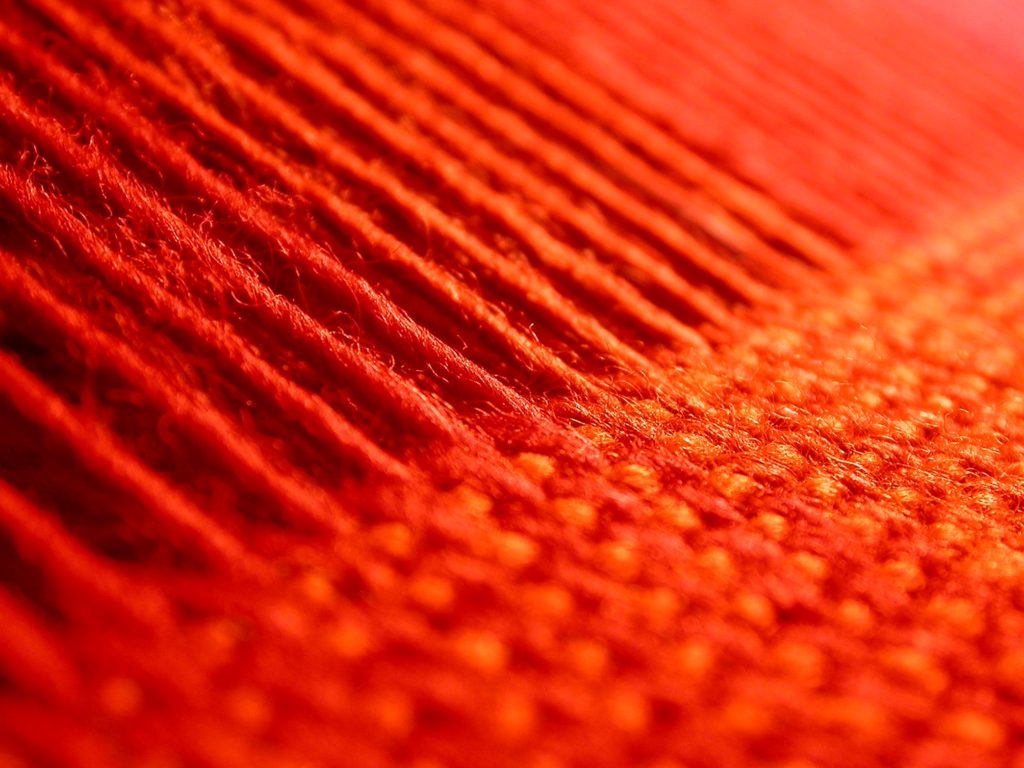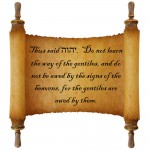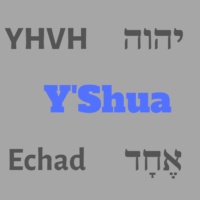
We have previously written an article about the scriptural prohibitions on the mixing of materials for clothing, seed and animals. From time to time we review our articles to make sure our convictions and understanding are honestly represented. We understand the need to remain teachable and we grow in understanding as we study YHVH’s Word.
We have been contemplating this mixing issue for quite a while and would like to share what we have learned. Our basic understanding is still the same in that we believe we are to take YHVH’s Word literally, but in context. We are also not to neglect the spiritual interpretation or lesson. It is easy to take the literal text out of context and apply it as law. In this way, it is controllable and measurable. However, we know YHVH is Spirit and we are to worship Him in Spirit and in truth.
In Spirit and in truth
This may not seem relevant to this topic, but I can assure you it is, for our perceptions and convictions are formed based on how we see and worship YHVH.
John 4:23–24
23 “But an hour is coming, and now is, when the true worshipers will worship the Father in spirit and truth; for such people the Father seeks to be His worshipers. 24 “Elohim is spirit, and those who worship Him must worship in spirit and truth.â€
Truth applied literally comes easier than spiritual application. It may also satisfy (being broken as we are) our performance-based relationship with YHVH. We may not even be consciously aware of it, but we may use obedience to YHVH’s instructions as a means to gain acceptance, love or blessings from Him. It is easier to see His instructions as rules we have to keep or suffer punishment than to see it as instructions by a loving Father for our benefit. When we see His instructions only as rules, we lose much of the significance of how YHVH intended it and we maintain a performace-based relationship with Him.
When we endeavour to seek also a spiritual understanding, we seek a relationship, because we have to rely on YHVH to show us what He really meant. Logic is under our control, but relationship asks of us to pray and wait and seek.
YHVH seeks worshippers. He doesn’t only seek worship, for worship can be given by pure compliance or rote routine. The word “worshipper” denotes a way of life, a giving of all and that is what YHVH requires.
We may maintain that we follow YHVH’s instructions out of love for our Father, but each of us has to really search ourselves to see if this is really the case. We may say and believe that, but deep down we may have a compulsion for obedience in order to earn love from YHVH and acceptance from others. We can identify it in ourselves as there are two things that go with a focus on performance: competitiveness and pride. Always seeking to do it better than others to ensure we are and remain acceptable and pride when we in our estimation do it well.
This is not what YHVH requires from us.
Micah 6:8
8 He has told you, O man, what is good; And what does YHVH require of you But to do justice, to love kindness, And to walk humbly with your Elohim?
David Stern explains this verse as follows:
This verse is sometimes misappropriated to support the mistaken idea that the Torah is inferior or is no longer in force, having been replaced by worship “in spirit and in truth†(the literal rendering of spiritually and truly). But spiritual and true worship is not to be set alongside or compared with the Torah. Rather, true, spiritual worship is God’s universal standard, which he also commands in the Torah itself. The Torah opposes legalism and the mere performance of acts and routines without true, spiritual involvement. 1
True humbleness is to put YHVH above ourselves, that means to put ourselves totally under His authority. Love and kindness are to allow ourselves and others to grow at our/their own pace. Justice is to do what is right in YHVH’s eyes. We are to be obedient to YHVH’s instructions, but this obedience is not to be based on performance to earn YHVH’s love or blessing. It is done because we place ourselves under His loving authority.
If we see YHVH’s instructions in this light, we stop regarding it as rules we have to keep to earn love or to avoid punishment, but it motivates us to endeavour to understand YHVH’s heart in the matter.
We also are to look at these instructions in the greater context of the chapters before and after and the entire Bible. Only then do we get a more accurate understanding. Context is part of the truth, it is the bigger picture.
Deception is easy
When we ignore context, we can easily be misled. We were reading a passage in Genesis recently and I realized how easy we can get ourselves caught up in deception. I want to share it with you.
Genesis 9:2–3
2 “The fear of you and the terror of you will be on every beast of the earth and on every bird of the sky; with everything that creeps on the ground, and all the fish of the sea, into your hand they are given. 3 “Every moving thing that is alive shall be food for you; I give all to you, as I gave the green plant.
When you read these two verses in isolation, you can draw the conclusion that you can eat the flesh of all living things and all green plants. However, if you know your Bible, you will know that YHVH, firstly, already made a distinction between clean and unclean animals before the flood and secondly, that He gave specific instructions in Leviticus 11 as to what is to be considered food. From Leviticus 11, we learn that some beasts, birds, creeping animals and fish were excluded. We also know that some plants are poisonous.
Another example can be found in the book of Acts. We all know that the vision of Peter is often used as proof that all animal flesh is good for food. However, we also know that when we read further, we learn that YHVH meant this vision to be understood in the context of gentile people.
We can find many similar examples in scripture. When we apply what we have learned here, we will be careful to take one verse in scripture and formulate doctrine based on it. Context is so immensely important.
Taking this into consideration, how do we apply this on what is written in Leviticus 19:19 and Deut 22:9-11?
Prohibitions against mixing
Leviticus 19:19
19 ‘You are to keep My statutes. You shall not breed together two kinds of your cattle; you shall not sow your field with two kinds of seed, nor wear a garment upon you of two kinds of material mixed together.
Deuteronomy 22:9–11
9 “You shall not sow your vineyard with two kinds of seed, or all the produce of the seed which you have sown and the increase of the vineyard will become defiled. 10 “You shall not plow with an ox and a donkey together. 11 “You shall not wear a material mixed of wool and linen together.
When we take these scriptures out of their context, it is easy to see it as rules to follow. End of story. Was this YHVH’s only intention with this? This is not necessarily wrong, but if we stop there, we may miss out or even be misled.
A logical conclusion?
We understand the three verses -Deuteronomy 22: 9-11-as an expansion of what is written in Leviticus 19:19.
It may be that YHVH used specific things the Israelites can relate to, to explain set-apartness to them? The people knew that it was not a good idea to mix animals, seed or weave linen and wool together.
Breeding two kinds of cattle together will cause the offspring to be of inferior quality or sterile in the case of some animals.
Mixing the seed of grains, for example, makes harvesting very difficult, even impossible. Mixing wool and linen by weaving them together may reduce the lifespan of the garment as wool may shrink more than linen when washed.
Some commentators concur with this:
The Commentary Critical and Explanatory on the Whole Bible explains it as follows:
19. Thou shalt not let thy cattle gender with a diverse kind—This prohibition was probably intended to discourage a practice which seemed to infringe upon the economy which God has established in the animal kingdom. 2
Ploughing with an ox and donkey together under the same yoke is inhumane to the donkey because the ox is far stronger.
Ellicott’s Commentary for English Readers explains this:
The rule about the ox and the ass may rest partly on the ground of humanity, the step and the pull of the two creatures being so very unlike. Paul gives a spiritual sense to the precept in 2Corinthians 6:14. “Be not unequally yoked together with unbelievers.” The ox was a clean animal and fit for sacrifice. The ass was unclean, and must be redeemed with a lamb. The clean and unclean must not till the holy land of Jehovah together. 3
This mixing will in each case have dire consequences and will end in destruction.
However, this very practical and logical explanation may actually seem redundant if the people already knew what best practice was. The crucial statement which YHVH repeated five times in the span of three chapters (Leviticus 18-21) is the warning for Israel not to do what these heathen nations did (Lev 18:3; Lev 18:24; Lev 18:27; Lev 18:30; Lev 20:23). YHVH was giving them specific examples of idolatrous practices He abhorred. He also repeated three times (Lev 19:2; Lev 20:7; Lev 20:26) that the people are to be holy for He YHVH their Elohim is holy.
Against idolatry?
Leviticus 18 commences with the following verse:
Leviticus 18:1–4
1 Then YHVH spoke to Moses, saying, 2 “Speak to the sons of Israel and say to them, ‘I am YHVH your Elohim. 3 ‘You shall not do what is done in the land of Egypt where you lived, nor are you to do what is done in the land of Canaan where I am bringing you; you shall not walk in their statutes. 4 ‘You are to perform My judgments and keep My statutes, to live in accord with them; I am YHVH your Elohim.
Then YHVH continues by giving His specific statues “by which a man may live if he does them.” YHVH continues throughout Leviticus 19 and 20 to give instructions for set-apartness. This was in stark contrast to what the Egyptians (where they came from) and Canaanites (where they were going) did. YHVH wants His people to be set apart. He does not want them to learn and imitate the practices of the nations. He said that in Lev 20:23-24.
Leviticus 20:23–24
23 ‘Moreover, you shall not follow the customs of the nation which I will drive out before you, for they did all these things, and therefore I have abhorred them. 24 ‘Hence I have said to you, “You are to possess their land, and I Myself will give it to you to possess it, a land flowing with milk and honey.†I am YHVH your Elohim, who has separated you from the peoples.
Maimonides or Rambam was a Jewish sage and scientist who understood Arabic. He studied the Nabatean writings specifically the writing “Nabatean Agriculture” and found compelling evidence that these prohibitions were given by YHVH to ensure that the Israelites did not engage in any forms of idolatry for many of the named practices were idolatrous in nature. The Nabateans or Sabiens (Zabiens) practised all these things as part of their idol worship. This writing (Nabatean Agriculture originates from Syria and it is written that its source was Babylonian and Chaldean practices of ancient times. Parts of this writing is still used as an occult source document today.
In Rambam’s book”A Guide for the Perplexed” he wrote about this. Pertaining to the mixing of linen and wool, he wrote:
We have explained in our large work that it is prohibited to round the corners of the head, and to mar the corners of the beard, because it was the custom of idolatrous priests. For the same reason, the wearing of garments made of linen and wool is prohibited: the heathen priests adorned themselves with garments containing vegetable and animal material, whilst they held in their hand a seal made of a mineral. This you find written in their books. The same is also the reason of the precept, “The woman shall not wear that which pertaineth unto a man” (Deut. xxii. 5). You find it in the book Tomtom, that a male person should wear coloured woman’s dress when he stands before Venus, and a female, when standing before Mars, should wear a buckler and other armour. I think that this precept has also another reason; namely, that the interchange of dress creates lust and leads to immorality.4
He also wrote the following about the custom to sow barley and stones of grapes together:
In the Nabatean Agriculture it is further distinctly stated that it was the custom of the people in those days to sow barley and stones of grapes together, in the belief that the vineyard could only prosper in this way. Therefore the Law prohibits us to use seed that has grown in a vineyard, and commands us to bum both the barley and the produce of the vineyard. For the practices of the heathen, which they considered as of a magic and talismanic character, even if not containing any idolatrous element, are prohibited, as we have stated above (p. 334) in reference to the dictum of our Sages, “We must not hang upon a tree the fÅ“tus of an animal belonging to the Sanctuary.” The Law prohibits all heathen customs, called by our Sages “the ways of the Amorite,” because they are connected with idolatry.
He concluded the chapter as follows:
It must now be clear to you, and no room can be left for any doubt, that the prohibition of wearing garments of wool and linen, of using the fruit of a tree in the first three years, and of mixing divers species, are directed against idolatry, and that the prohibition against adopting heathen manners serves to remove anything which leads to idolatry, as has been shown by us.
Rambam was not the only scholar who saw it this way.
Here is the Commentary Critical and Explanatory on the Whole Bible’s explanation on the mixing of seed and threads.
Thou shalt not sow thy field with mingled seed—This also was directed against an idolatrous practice, namely, that of the ancient Zabians, or fire-worshippers, who sowed different seeds, accompanying the act with magical rites and invocations; and commentators have generally thought the design of this and the preceding law was to put an end to the unnatural lusts and foolish superstitions which were prevalent among the heathen. But the reason of the prohibition was probably deeper: for those who have studied the diseases of land and vegetables tell us, that the practice of mingling seeds is injurious both to flowers and to grains. “If the various genera of the natural order Gramineae, which includes the grains and the grasses, should be sown in the same field, and flower at the same time, so that the pollen of the two flowers mix, a spurious seed will be the consequence, called by the farmers chess. It is always inferior and unlike either of the two grains that produced it, in size, flavor, and nutritious principles. Independently of contributing to disease the soil, they never fail to produce the same in animals and men that feed on them†[WHITLAW].
neither shall a garment mingled of linen and woollen come upon thee—Although this precept, like the other two with which it is associated, was in all probability designed to root out some superstition, it seems to have had a further meaning. The law, it is to be observed, did not prohibit the Israelites wearing many different kinds of cloths together, but only the two specified; and the observations and researches of modern science have proved that “wool, when combined with linen, increases its power of passing off the electricity from the body. In hot climates, it brings on malignant fevers and exhausts the strength; and when passing off from the body, it meets with the heated air, inflames and excoriates like a blister†[WHITLAW]. (See Ez 44:17, 18).5
Gordon Fee and Douglas Stuart:
These and other prohibitions were designed to forbid the Israelites to engage in fertility cult practices of the Canaanites. The Canaanites believed in sympathetic magic, the idea that symbolic actions can influence the gods and nature…. Mixing animal breeds, seeds, or materials was thought to “marry†them†so as magically to produce “offspring,†that is, agricultural bounty in the future.6
Another explanation that is often given to explain the prohibition against mixing linen and wool is as follows:
The garments of the High Priest and the curtains of the Tabernacle
In both Judaism and some Messianic groups, it is taught that the prohibition against mixing threads, applies only to linen and wool. They also teach that it is prohibited because of the set-apartness of the garments of the High Priest and the curtains of the Tabernacle.
Another instruction, the prohibition against making the spice mixture for the incense altar is applied to the making of garments similar to the priestly garments.
Exodus 30:37–38
37 “The incense which you shall make, you shall not make in the same proportions for yourselves; it shall be holy to you for YHVH. 38 “Whoever shall make any like it, to use as perfume, shall be cut off from his people.â€
However, this prohibition is specific to incense and has no application in the making of the priestly garments. For this reason, I do not see this as a correct interpretation. If it was prohibited, for this reason, I think YHVH would have said so and not group it together with instructions about seed and animals.
Also, when we read the instructions for the garments of the high priest and curtains for the tabernacle, we read of blue, purple and crimson yarns.
Exodus 25:4
4 blue, purple, and crimson yarns, and fine linen and goat hair,
When I looked this up in the Lexicon, it indicated that it could be translated as woollen yarn or fine linen. The translators chose to translate it as woollen yarn. I understand this to be a wrong translation or assumption. In Karaite Judaism for example, it is understood to be yarns of fine linen. Here is a quote from a Karaite translation.
then they should bring any of the following items: Metals of gold, silver, and bronze; yarn of blue, purple, and scarlet byssus (fine linen); 7
From this information, we can conclude that the priestly garments and curtains of the tabernacle were not made of fibres of wool and linen mixed together, as taught, but of different colours of fine linen, scarlet, blue and purple.
Conclusion
I have heard a saying “There is comfort in extremism, being balanced is the real challenge.” I believe it to be true especially in the Messianic movement. We have come across people with very extreme ideas and the fruit thereof is not to draw people to YHVH or to Torah, but the opposite. I can also speak from experience. It is easy to look at a verse, interpret it literally and endeavour to do it. The question is, was this YHVH’s intention or are we laying a yoke upon ourselves and other people? I love wearing 100% cotton, linen or wool. It is comfortable, breathes and looks beautiful.
The question is: did YHVH in Lev 19:19 and Deut 22:9 instruct us against wearing a garment made of 98%cotton and 2% spandex or viscose mixed with linen? Or was He teaching us something totally different? I would err on the side of caution and not wear a garment made of a mixture of linen and wool, but I do not think we are to expand our understanding to other fibres. Allow me to explain.
After this study, I do believe YHVH’s intention to be somewhat different from my previous understanding. YHVH was teaching His people not to mix with the nations and not to partake in their superstitions and idolatrous practices. They were on their way to Canaan, a land inhabited by unbelieving Canaanites. People who worshipped idols and did not live according to YHVH’s standards. YHVH knew the future and was warning them. He wanted to make it clear to them what the consequences of such mixing would be.
In Leviticus 18 He prohibits certain acts of immorality and in Leviticus 21, He tells them what the punishments for these acts would be. So, from this, we see it is one greater context. For this reason, I do not believe it correct to take these few verses in Leviticus and Deuteronomy out of its context and make it a rule unto itself.
As I said, I would not wear material of linen and wool mixed together or breed different cattle or even mix seed, but to take it out of context and make a yoke of it, it not the way to do it. In this way, we lose the context and with it the broader interpretation not to mix with or do what the heathens do. Set apartness is not a tunnel vision interpretation of a few verses out of context. We are to be diligent to study YHVH’s word in context and not use it to create yokes for us and others to carry for that is what the Pharisees did, and Y’shua did not approve. He said in Matthew 11:30 “My yoke is easy and My burden is light”
References
- Stern, D. H. (1996). Jewish New Testament Commentary: a companion volume to the Jewish New Testament (electronic ed., Jn 4:24). Clarksville: Jewish New Testament Publications.
- Jamieson, R., Fausset, A. R., & Brown, D. (1997). Commentary Critical and Explanatory on the Whole Bible (Vol. 1, p. 87). Oak Harbor, WA: Logos Research Systems, Inc.
- https://biblehub.com/deuteronomy/22-9.htm
- http://www.sacred-texts.com/jud/gfp/gfp173.htm
- Jamieson, R., Fausset, A. R., & Brown, D. (1997). Commentary Critical and Explanatory on the Whole Bible (Vol. 1, p. 87). Oak Harbor, WA: Logos Research Systems, Inc.
- https://www.thinkingchristian.net/posts/2013/01/why-wearin
- https://www.karaites.org/terumah.html









Leave a Reply